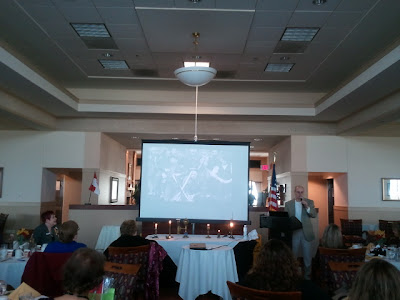I "borrowed" this from the Adventures in Genealogy Education Blog - thanks, Angela, for posting. She credits this as follows:
I have seen this genealogy meme on other blogs, but it was the post on Sheri Fenley's blog, The Educated Genealogist, that got me to decide to participate. Sheri credits the original author Becky Wiseman, the Traveling Genie and author of Kinexxions, who came up with this meme as sort of a self-evaluator of one's genealogical experience.
My score is in
purple.
99 103 Genealogy Things
1. Belong to a genealogical society
2. Joined a group on Genealogy Wise.
3. Transcribed records.
4. Uploaded headstone pictures to Find-A-Grave or a similar site
5. Documented ancestors for four generations (self, parents, grandparents, great-grandparents)
6. Joined Facebook.
7. Cleaned up a run-down cemetery.
8. Joined the Genea-Bloggers Group.
9. Attended a genealogy conference.
10. Lectured at a genealogy conference.
11. Spoke on a genealogy topic at a local genealogy society/local library’s family history group.
12. Joined the National Genealogical Society.
13. Contributed to a genealogy society publication.
14. Served on the board or as an officer of a genealogy society.
15. Got lost on the way to a cemetery.
16. Talked to dead ancestors.
17. Researched outside the state in which I live.
18. Knocked on the door of an ancestral home and visited with the current occupants.
19. Cold called a distant relative.
20. Posted messages on a surname message board.
21. Uploaded a gedcom file to the internet.
22. Googled my name (and those of ancestors)
23. Performed a random act of genealogical kindness.
24. Researched a non-related family, just for the fun of it.
25. Have been paid to do genealogical research.
26. Earn a living (majority of income) from genealogical research.
27. Wrote a letter (or email) to a previously unknown relative.
28. Contributed to one of the genealogy carnivals.
29. Responded to messages on a message board.
30. Was injured while on a genealogy excursion.
31. Participated in a genealogy meme.
32. Created family history gift items.
33. Performed a record lookup.
34. Took a genealogy seminar cruise.
35. Am convinced that a relative must have arrived here from outer space.
36. Found a disturbing family secret.
37. Combined genealogy with crafts (family picture quilt, scrapbooking).
38. Think genealogy is a passion and/or obsession not a hobby.
39. Assisted finding next of kin for a deceased person.
40. Taught someone else how to find their roots.
41. Lost valuable genealogy data due to a computer crash or hard drive failure.
42. Been overwhelmed by available genealogy technology.
43. Know a cousin of the 4th degree or higher.
44. Disproved a family myth through research.
45. Got a family member to let you copy photos.
46. Used a digital camera to “copy” photos or records.
47. Translated a record from a foreign language.
48. Found an immigrant ancestor’s passenger arrival record.
49. Looked at census records on microfilm, not on the computer.
50. Used microfiche.
51. Visited the Family History Library in Salt Lake City.
52. Used Google+ for genealogy.
53. Visited a church or place of worship of one of your ancestors.
54. Taught a class in genealogy.
55. Traced ancestors back to the 18th Century.
56. Traced ancestors back to the 17th Century.
57. Traced ancestors back to the 16th Century.
58. Can name all of your great-great-grandparents.
59. Know how to determine a soundex code without the help of a computer.
60. Have found many relevant and unexpected articles on internet to “put flesh on the bones”.
61. Own a copy of Evidence Explained by Elizabeth Shown Mills.
62. Helped someone find an ancestor using records you had never used for your own research.
63. Visited the main National Archives building in Washington, DC.
64. Have an ancestor who came to America as an indentured servant.
65. Have an ancestor who fought in the Revolutionary War, War of 1812 or Civil War.
66. Taken a photograph of an ancestor’s tombstone.
67. Can “read” a church record in Latin.
68. Have an ancestor who changed his/her name, just enough to be confusing.
69. Joined a Rootsweb mailing list.
70. Created a family website.
71. Have a genealogy blog.
72. Was overwhelmed by the amount of family information received from someone.
73. Have broken through at least one brick wall.
74. Done genealogy research at a court house.
75. Borrowed microfilm from the Family History Library
76. Found an ancestor in an online newspaper archive.
77. Have visited a NARA branch.
78. Have an ancestor who served in WWI or WWII.
79. Use maps in my genealogy research.
80. Have a blacksheep ancestor.
81. Found a bigamist amongst my ancestors.
82. Attended a genealogical institute.
83. Taken online genealogy (and local history) courses.
84. Consistently (document) and cite my sources.
85. Visited a foreign country (i.e. one I don’t live in) in search of ancestors.
86. Can locate any document in my research files within a few minutes.
87. Have an ancestor who was married four times.
88. Made a rubbing of an ancestor’s gravestone.
89. Followed genealogists on Twitter.
90. Published a family history book.
91. Offended a family member with my research.
92. Reunited someone with precious family photos or artifacts.
93. Have a paid subscription to a genealogy database.
94. Submitted articles for FamilySearch Wiki.
95. Organized a family reunion.
96. Converted someone new to the love of all things genealogy.
97. Have done the genealogy happy dance.
98. Visited the DAR Library in Washington D.C.
99. Have done indexing for Family Search Indexing or another genealogy project.
100. Visited the Allen County Public Library Genealogy Center in Fort Wayne, Indiana.
101. Had an amazing serendipitous find of the "Psychic Roots" variety.
102. Visited the Library of Congress.
103. Belong to a lineage society
Of course, that is 86 things up until today... (some are definitely on my to-do list)













































